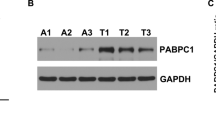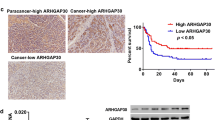Abstract
Pancreatic cancer (PC) is one of the most common cancers worldwide and a leading cause of cancer-related death. Discovering novel targets is a key for its therapy. Carboxypeptidase E (CPE), a subtype of the pro-protein convertases, has been shown to be upregulated in many types of cancer, yet its function in PC remains elusive. The expressions of CPE in PC cell lines and cancer patients were investigated by Western blot and qRT-PCR. In PC cell line BX-pc-3, CPE was downregulated and its effect on cancer cell proliferation, migration, cisplatin chemosensitivity, and in vivo tumor growth was analyzed by Western blot, proliferation assay, invasion assay, and in vivo transplantation, respectively. The expression of nuclear factor-kappaB (NF-κB), a possible downstream target of CPE was examined by Western blot upon CPE regulation in PC cells, and the effects of inhibiting NF-κB on PC cell invasion and proliferation were examined. CPE was significantly upregulated in PC cell lines and tumor tissues. Proliferation and invasion assays indicated that downregulation of CPE inhibited cancer cell growth and migration and increased chemosensitivity to cisplatin. Inoculation of small interfering RNA (siRNA) transfected BX-pc-3 cells into null mice demonstrated that downregulation of CPE prevented tumor growth in vivo. NF-κB was directly regulated by CPE in pancreatic cancer, and siRNA-mediated inhibition of NF-κB exerted similar anti-tumor effect as downregulating CPE. Taken together, our results demonstrate that CPE plays an important role in pancreatic cancer. Inhibition of CPE may serve as a potential target for PC therapeutics.




Similar content being viewed by others
References
Jemal A, Siegel R, Xu J, Ward E. Cancer statistics, 2010. CA Cancer J Clin. 2010;60:277–300.
Chen W, Zheng R, Zhang S, Zhao P, Li G, Wu L, et al. Report of incidence and mortality in china cancer registries, 2009. Chin J Cancer Res. 2013;25:10–21.
Hirata K, Egawa S, Kimura Y, Nobuoka T, Oshima H, Katsuramaki T, et al. Current status of surgery for pancreatic cancer. Dig Surg. 2007;24:137–47.
Gillen S, Schuster T, Meyer Zum Buschenfelde C, Friess H, Kleeff J. Preoperative/neoadjuvant therapy in pancreatic cancer: a systematic review and meta-analysis of response and resection percentages. PLoS Med. 2010;7:e1000267.
Reznik R, Hendifar AE, Tuli R. Genetic determinants and potential therapeutic targets for pancreatic adenocarcinoma. Front Physiol. 2014;5:87.
Satoh K. The molecular mechanism in tumorigenesis and development of pancreatic cancer. Nihon Shokakibyo Gakkai zasshi Jpn J Gastroenterol. 2013;110:2042–50.
Fricker LD. Carboxypeptidase E. Annu Rev Physiol. 1988;50:309–21.
Pla V, Paco S, Ghezali G, Ciria V, Pozas E, Ferrer I, et al. Secretory sorting receptors carboxypeptidase e and secretogranin III in amyloid beta-associated neural degeneration in Alzheimer's disease. Brain Pathol. 2013;23:274–84.
McGirr R, Guizzetti L, Dhanvantari S. The sorting of proglucagon to secretory granules is mediated by carboxypeptidase E and intrinsic sorting signals. J Endocrinol. 2013;217:229–40.
Steiner DF. The proprotein convertases. Curr Opin Chem Biol. 1998;2:31–9.
Naggert JK, Fricker LD, Varlamov O, Nishina PM, Rouille Y, Steiner DF, et al. Hyperproinsulinaemia in obese fat/fat mice associated with a carboxypeptidase e mutation which reduces enzyme activity. Nat Genet. 1995;10:135–42.
Cawley NX, Yanik T, Woronowicz A, Chang W, Marini JC, Loh YP. Obese carboxypeptidase E knockout mice exhibit multiple defects in peptide hormone processing contributing to low bone mineral density. Am J Physiol Endocrinol Metab. 2010;299:E189–97.
Yang L, Zhou Z, Du T, Tan S, Zhnag Y, Jin P. Detection of carboxypeptidase h specific t cells in peripheral blood of latent autoimmune diabetic patients with carboxypeptidase antibody positivity by ELISPOT assay. Zhong nan da xue xue bao Yi xue ban J Cent South Univ Med Sci. 2009;34:1011–6.
Murthy SR, Dupart E, Al-Sweel N, Chen A, Cawley NX, Loh YP. Carboxypeptidase e promotes cancer cell survival, but inhibits migration and invasion. Cancer Lett. 2013;341:204–13.
Cawley NX, Wetsel WC, Murthy SR, Park JJ, Pacak K, Loh YP. New roles of carboxypeptidase E in endocrine and neural function and cancer. Endocr Rev. 2012;33:216–53.
Skalka N, Caspi M, Caspi E, Loh YP, Rosin-Arbesfeld R. Carboxypeptidase E: a negative regulator of the canonical Wnt signaling pathway. Oncogene. 2013;32:2836–47.
Zhou K, Liang H, Liu Y, Yang C, Liu P, Jiang X. Overexpression of CPE-∆N predicts poor prognosis in colorectal cancer patients. Tumour Biol. 2013;34:3691–9.
Lee TK, Murthy SR, Cawley NX, Dhanvantari S, Hewitt SM, Lou H, et al. An N-terminal truncated carboxypeptidase e splice isoform induces tumor growth and is a biomarker for predicting future metastasis in human cancers. J Clin Invest. 2011;121:880–92.
Murthy SR, Pacak K, Loh YP. Carboxypeptidase E: elevated expression correlated with tumor growth and metastasis in pheochromocytomas and other cancers. Cell Mol Neurobiol. 2010;30:1377–81.
Wang CY, Mayo MW, Baldwin Jr AS. TNF- and cancer therapy-induced apoptosis: Potentiation by inhibition of NF-kappaB. Science. 1996;274:784–7.
Dolcet X, Llobet D, Pallares J, Matias-Guiu X. NF-κB in development and progression of human cancer. Virchows Archiv Int J Pathol. 2005;446:475–82.
Lee CH, Jeon YT, Kim SH, Song YS. NF-kappaB as a potential molecular target for cancer therapy. BioFactors. 2007;29:19–35.
Thomas RP, Farrow BJ, Kim S, May MJ, Hellmich MR, Evers BM. Selective targeting of the nuclear factor-kappaB pathway enhances tumor necrosis factor-related apoptosis-inducing ligand-mediated pancreatic cancer cell death. Surgery. 2002;132:127–34.
Xiong HQ, Abbruzzese JL, Lin E, Wang L, Zheng L, Xie K. NF-kappaB activity blockade impairs the angiogenic potential of human pancreatic cancer cells. Int J Cancer. 2004;108:181–8.
Biliran Jr H, Wang Y, Banerjee S, Xu H, Heng H, Thakur A, et al. Overexpression of cyclin D1 promotes tumor cell growth and confers resistance to cisplatin-mediated apoptosis in an elastase-myc transgene-expressing pancreatic tumor cell line. Clin Cancer Res Off J Am Assoc Cancer Res. 2005;11:6075–86.
Furukawa T, Duguid WP, Rosenberg L, Viallet J, Galloway DA, Tsao MS. Long-term culture and immortalization of epithelial cells from normal adult human pancreatic ducts transfected by the E6E7 gene of human papilloma virus 16. Am J Pathol. 1996;148:1763–70.
Zhang L, Mizumoto K, Sato N, Ogawa T, Kusumoto M, Niiyama H, et al. Quantitative determination of apoptotic death in cultured human pancreatic cancer cells by propidium iodide and digitonin. Cancer Lett. 1999;142:129–37.
Krajnik M, Schafer M, Sobanski P, Kowalewski J, Bloch-Boguslawska E, Zylicz Z, et al. Enkephalin, its precursor, processing enzymes, and receptor as part of a local opioid network throughout the respiratory system of lung cancer patients. Hum Pathol. 2010;41:632–42.
Chandler NM, Canete JJ, Callery MP. Increased expression of NF-kappa B subunits in human pancreatic cancer cells. J Surg Res. 2004;118:9–14.
Li Y, Ellis KL, Ali S, El-Rayes BF, Nedeljkovic-Kurepa A, Kucuk O, et al. Apoptosis-inducing effect of chemotherapeutic agents is potentiated by soy isoflavone genistein, a natural inhibitor of NF-kappaB in BxPC-3 pancreatic cancer cell line. Pancreas. 2004;28:e90–5.
Arlt A, Gehrz A, Muerkoster S, Vorndamm J, Kruse ML, Folsch UR, et al. Role of NF-kappaB and Akt/PI3K in the resistance of pancreatic carcinoma cell lines against gemcitabine-induced cell death. Oncogene. 2003;22:3243–51.
Wang Z, Zhang Y, Li Y, Banerjee S, Liao J, Sarkar FH. Down-regulation of Notch-1 contributes to cell growth inhibition and apoptosis in pancreatic cancer cells. Mol Cancer Ther. 2006;5:483–93.
Shah SA, Potter MW, Hedeshian MH, Kim RD, Chari RS, Callery MP. Pi-3' kinase and NF-kappaB cross-signaling in human pancreatic cancer cells. J Gastrointest Surg Off J Soc Surg Aliment Tract. 2001;5:603–12. discussion 612–603.
Author information
Authors and Affiliations
Corresponding author
Rights and permissions
About this article
Cite this article
Liu, A., Shao, C., Jin, G. et al. Downregulation of CPE regulates cell proliferation and chemosensitivity in pancreatic cancer. Tumor Biol. 35, 12459–12465 (2014). https://doi.org/10.1007/s13277-014-2564-y
Received:
Accepted:
Published:
Issue Date:
DOI: https://doi.org/10.1007/s13277-014-2564-y




